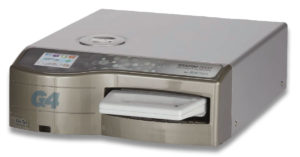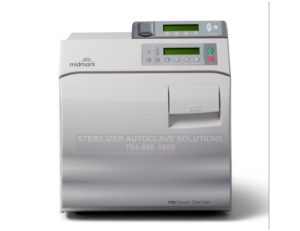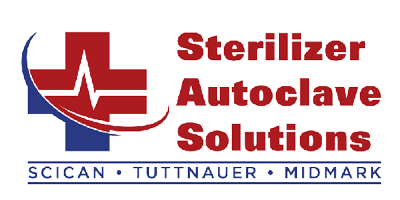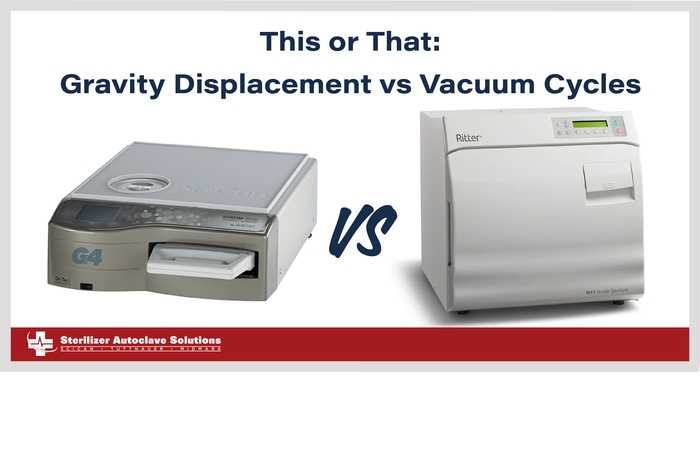This or That: Gravity vs Vacuum Cycles
One of the most important things when looking into an autoclave for your practice is extensive research. These days, there are almost too many different units to keep track of. Each one sports different features that range from size to cycles, and that’s not even scratching the surface. Knowing the differences of each machine and comparing that to what your practice needs is an important step. So with this article, we’d like to look into one of the most important factor in determining the autoclave you need; cycle type. Specifically, looking into the pros and cons of two cycle types, gravity displacement and pre/post vacuum cycles. Class N vs. Class B units.
Each cycle has its own set of pros and cons that must be considered in order to best match the specific needs of your practice. By comparing and contrasting these two widely-used autoclave cycles, we aim to provide valuable insights into the advantages and disadvantages of each method. This can help customers make informed decisions, ensuring that your investment is put into the right resources.
Gravity Sterilization
First, let’s talk about Class N autoclaves that utilize gravity sterilization. Gravity sterilization is the process of pumping steam into the autoclave chamber that contains ambient air. Because the steam is heavier than the surrounding air, it can displace the air without mechanical help. So, the steam pushes the air completely our of the chamber through a drain port.
It’s a fascinating process of sterilization unique to gravity sterilizers. And like anything, it has its pros and cons.
Pros:
They can be highly dependable and cost-effective machines due to their simple designs.
Because of how gravity sterilization works, they can be independent. Gravity sterilizers don’t need external peripheral devices or machines to connect to.
While not being able to be used for more advanced tools, gravity sterilization can still be used in a large range of general sterilization. Things like stainless steel instruments, solid, simple glassware, biohazard waste and unwrapped goods.
Cons:
Gravity sterilizers lack a vacuum cycle, so steam penetration isn’t something these sterilizers are capable of.
The Statim G4 2000

The Statim G4 2000– a modern improvement to a tried-and-true SciCan original. The cassette autoclave that took sterilization by storm along with its partner, the G4 5000. The SciCan Statim G4 2000 is a cassette autoclave that utilizes gravity displacement sterilization. Along with its unique sterilization, the G4 2000 sports some incredible features that give it its well known reputation. The SciCan Statim G4 2000 includes features like:
- Fast Cycle Times
- Small Footprint
- Data Protection
- Gentle Cycles for Sensitive Materials
- 3.5 inch High-Res Touch Screen
Including the benefits of SciCan’s patented G4 technology, which brings features like:
- Monitoring real-time cycle data
- Instant data logging
- Proactive maintenance management
- Automatic system updates to your G4 machines
Vacuum Sterilization
Now we move on to vacuum sterilization, Class B. These are becoming the standard class for autoclaves based on evolving regulations from organizations like the CDC. Class B autoclaves are effective in many ways because they utilize vacuum cycle sterilization.
Vacuum sterilization is the process in which steam injections and vacuum draws are alternated, forming vacuum pulses. These pulses dynamically remove air from the chamber and have a unique effect on the instruments. The vacuum effect allows the steam to make its way into areas it normally couldn’t reach without the force of the vacuum suction.
Needless to say, vacuum cycles provide a vastly different approach to sterilization processing. This in turn, makes them effective for more advanced sterilization tasks. But like anything, vacuum sterilization has pros and cons.
Pros:
Vacuum sterilizers can perform more advanced sterilization with things like wrapped and porous loads.
They’re meant to comply with the most rigorous sterilization standards and can meet the high demands of high-standard practices.
They can be used on a number of intricate items like wrapped loads, porous instruments, syringes, pipette tips and more.
Some modern models sport eco-friendly features, regarding energy and water consumption.
Cons:
Pre/post vacuum sterilization will definitely cost more than something of general use.
The Midmark M11 Ultraclave

One great example of a pre/post vac autoclave is a Midmark staple, their Midmark M11 autoclave. Able to sterilize both heat and moisture stable items, this unit sports a sizeable 11″ x 18″ chamber, making it one of the largest tabletop sterilizers on the market. With space like this, the M11 can sterilize larger packs and instruments without any hassle. And the size isn’t the only notable feature. The Midmark M11 Ultraclave comes built-in with a wealth of different features.
Those features include:
- Automatic opening door
- Large 11” x 18” chamber
- Easy “two-button” startup and operation
- Single button programmable cycles
- Bright green LCD display for easy navigation
- “Set-and-forget” simple operation
- Attachable USB data logger for easy transfer and data management
Final Thoughts
Comparing and contrasting gravity displacement and pre/post vacuum cycles helps to gain a better understanding of the pros and cons associated with each method. While different factors may skew statistics, this doesn’t mean that one is better than the other. And that’s something important to remember. This knowledge enables you to make informed decisions that align with the specific needs of your practice. By selecting the most suitable sterilization method, you and any other healthcare professionals can ensure optimal sterilization outcomes. Which, in turn, helps to maintain a safe and hygienic environment for both patients and staff.
If you’d like to find other Class B or Class N units, you can browse our vast autoclave selection here on our website. Or, if you have any questions about gravity displacement cycles, pre/post vacuum cycles, or anything else, call us at 704-966-1650, or you can find us using the links to our other programs below.
As always if you have any questions about this process or anything else please feel free to contact us and take advantage of our “FREE TECH SUPPORT.”
We also offer FREE VIRTUAL TECH SUPPORT to “See and Talk” with a “Real Time Live Technician” for any problems you may be in need of help with.
You can also use our “FREE MAINTENANCE PROGRAM”. Take the guesswork and worrying about what unit is due for maintenance and which maintenance cycle it is time for. We will keep track of all your autoclaves and let you know when it’s time for anything.


